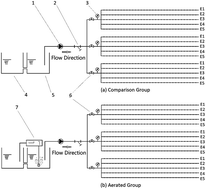Influence of micro/nanobubbles on clogging in drip irrigation systems
Abstract
Drip emitter clogging is closely related to the presence of particulate matter, nutrients, organic matter and microorganisms in irrigation water and severely restricts the performance, service life and popularization of drip irrigation systems. Micro/nanobubbles can effectively remove suspended particles in water, limit microbial activity, and significantly increase the concentration of dissolved oxygen in water to promote crop growth. However, the effects of micro/nanobubbles on drip emitter clogging remain to be studied. Thus, taking micro/nanoaerated drip irrigation as the research object, five different types of emitters were selected, and the clogging characteristics of the different types of emitters under micro/nanoaerated conditions were studied by performing an emitter clogging test. The influence of emitter clogging on the uniformity of the irrigation provided by the micro/nanoaerated drip system was explored. The results showed that emitter clogs developed gradually and that the clogging developed slowly at the early stage of irrigation. When a slight clogging occurred, the emitter clogged rapidly, resulting in severe or even complete clogging. The cylindrical emitters had the worst anti-clogging performance among the tested emitters, while the emitters with no pressure compensation function and high rated flows had the better performance. Micro/nanoaeration had a significant effect on emitter clogging and increased the normal working times of the E1, E2, E3, E4 and E5 emitters by 38%, 20%, 30%, 28% and 130%, respectively. In addition, micro/nanoaeration reduced the sensitivity of the Christiansen uniformity coefficient (Cu) and the statistical uniformity coefficient (Us) in the drip system to the discharge ratio variation (Dra) and enhanced the stability of the uniformity coefficients of the drip system. Therefore, micro/nanoaeration can help to inhibit clog development in emitters, extend the service life of emitters, and maintain good uniformity in drip irrigation systems. The results of this paper provide a theoretical reference for revealing the clogging mechanisms of micro/nanoaerated drip irrigation emitters and provide theoretical support for the efficient operation of micro/nanoaerated drip irrigation systems.



 Please wait while we load your content...
Please wait while we load your content...